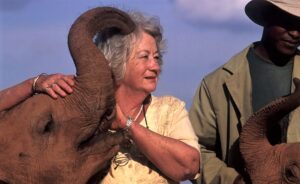Archive for September 11th, 2022
» posted on Sunday, September 11th, 2022 by Linda Lou Burton
Benjamin and the Green Chair
 Linda Lou Burton posting from Nairobi, Kenya – I saw him bringing a chair as I approached the house. By the time I was there, he’d made a perfect spot for me. At last, I was seated on Karen Blixen’s verandah! Here’s me, holding the book Karen Blixen wrote; which was the inspiration that brought me here to Nairobi. I wanted to see what Karen saw. I wanted to see Africa. Now, here I was, looking out over the wide lawn, seated in a green plastic chair, all mixed up with emotions. “The past is never past,” it’s been said, and by golly, it’s true. The past is only how we remember it, and even that changes over time. When Karen wrote Out of Africa she was already back in Denmark, recalling moments that were precious to her; or heart-wrenchingly sad. Chapter titles reveal her swings in thought: The Ngong Farm. A Native Child. A Gazelle. Riding in the Reserve. The Shooting Accident. Big Dances. A Kikuyu Chief. Somali Women. Old Knudsen. Visits of Friends.
Linda Lou Burton posting from Nairobi, Kenya – I saw him bringing a chair as I approached the house. By the time I was there, he’d made a perfect spot for me. At last, I was seated on Karen Blixen’s verandah! Here’s me, holding the book Karen Blixen wrote; which was the inspiration that brought me here to Nairobi. I wanted to see what Karen saw. I wanted to see Africa. Now, here I was, looking out over the wide lawn, seated in a green plastic chair, all mixed up with emotions. “The past is never past,” it’s been said, and by golly, it’s true. The past is only how we remember it, and even that changes over time. When Karen wrote Out of Africa she was already back in Denmark, recalling moments that were precious to her; or heart-wrenchingly sad. Chapter titles reveal her swings in thought: The Ngong Farm. A Native Child. A Gazelle. Riding in the Reserve. The Shooting Accident. Big Dances. A Kikuyu Chief. Somali Women. Old Knudsen. Visits of Friends.
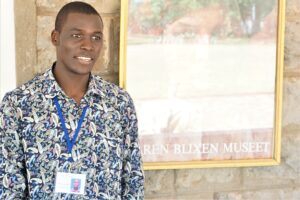 I’d come to see what I could see TODAY, that linked to Karen’s memories, and Benjamin was geared to tell. Benjamin was a handsome young man, a college student being funded by his work at the Museum. He knew his stuff; I’ve been studying Karen Blixen’s story for a long time, yet he told things I’d never heard before as he pointed to various posters displayed on the porch. Then it was time to go inside.
I’d come to see what I could see TODAY, that linked to Karen’s memories, and Benjamin was geared to tell. Benjamin was a handsome young man, a college student being funded by his work at the Museum. He knew his stuff; I’ve been studying Karen Blixen’s story for a long time, yet he told things I’d never heard before as he pointed to various posters displayed on the porch. Then it was time to go inside.
House Museums are generally stingy with what they allow visitors to do; and this was no exception. “No pictures,” Benjamin said, “but I’m bringing this chair inside so you can comfortably sit and hear what I say.” He led the way, green chair in hand, as we started out in the drawing room. My visions of the house (as I read the book) were completely dominated by the images in the 1985 Streep/Redford movie, and Benjamin assured us they were “basically” correct. Kumante Gatura, a Kikuyu who entered Karen’s life as a small boy and worked in the house until she left, was alive and on set during the movie-making, and gave his advice as to the correctness of what Sydney Pollack was trying to do.
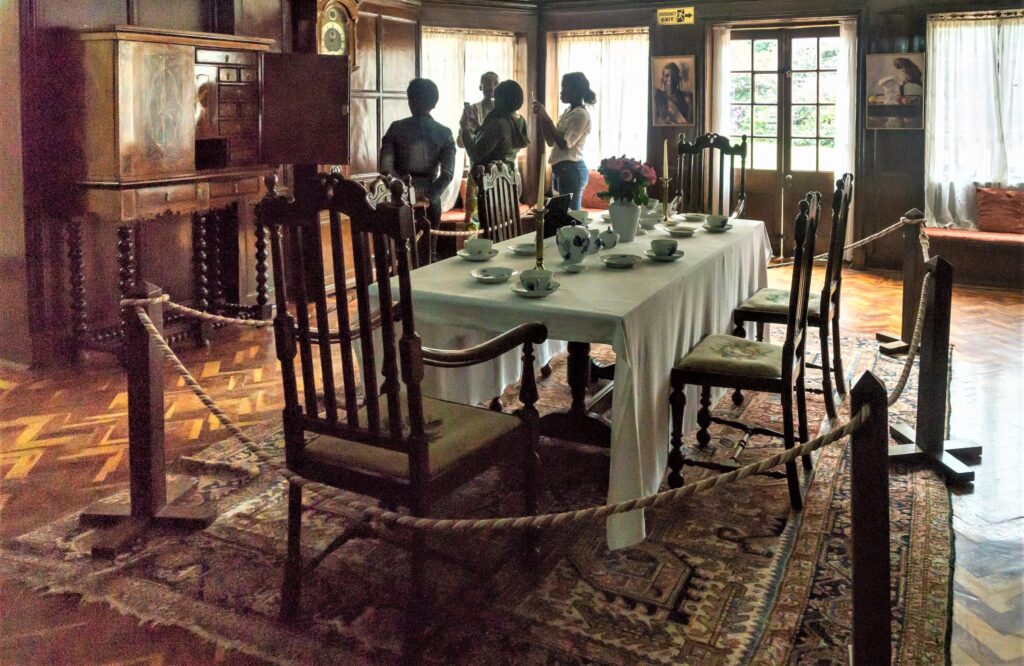 Benjamin moved my green chair from room to room, where I sat (and Rick stood) as he pointed out details – the dining table where Prince Edward sat during his 1928 visit; the desk where Karen sat to manage farm business, the cuckoo clock the children sneaked in to watch, the lion-skin rug. He had a story to tell about each, and he told each one with vigor, putting us there, in the moment. I wish I could show you what I saw, but I obeyed the rules. Which means, of course, any “inside photos” are lifted off a google search.
Benjamin moved my green chair from room to room, where I sat (and Rick stood) as he pointed out details – the dining table where Prince Edward sat during his 1928 visit; the desk where Karen sat to manage farm business, the cuckoo clock the children sneaked in to watch, the lion-skin rug. He had a story to tell about each, and he told each one with vigor, putting us there, in the moment. I wish I could show you what I saw, but I obeyed the rules. Which means, of course, any “inside photos” are lifted off a google search.
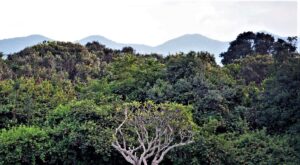 And then we were back outside, walking the grounds. Benjamin showed us how coffee beans grow on a tree (yes, one or two trees were left near the house). He pointed to the hills visible beyond the trees. “Those are the Ngong Hills Karen wrote about,” he said, “and that’s where Denys is buried. Ngong is a Swahili word for knuckles,” Benjamin
And then we were back outside, walking the grounds. Benjamin showed us how coffee beans grow on a tree (yes, one or two trees were left near the house). He pointed to the hills visible beyond the trees. “Those are the Ngong Hills Karen wrote about,” he said, “and that’s where Denys is buried. Ngong is a Swahili word for knuckles,” Benjamin 
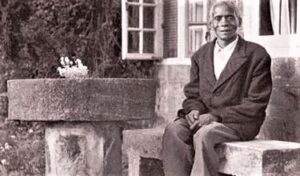 explained, holding up his folded hand to show the knuckles matching the hills in the distance. The large stone terrace at the back of the house is where Karen held “clinic” every morning at 9, Benjamin pointed out, dispensing first aid as needed to the natives who worked on her farm. Kumante helped with this every day. Rick and I posed for a picture between the two large millstone tables where they sat. I found a picture (online) of Kumante as an old man, sitting back there. I’m guessing it was when he came to assist in the movie-making.
explained, holding up his folded hand to show the knuckles matching the hills in the distance. The large stone terrace at the back of the house is where Karen held “clinic” every morning at 9, Benjamin pointed out, dispensing first aid as needed to the natives who worked on her farm. Kumante helped with this every day. Rick and I posed for a picture between the two large millstone tables where they sat. I found a picture (online) of Kumante as an old man, sitting back there. I’m guessing it was when he came to assist in the movie-making.
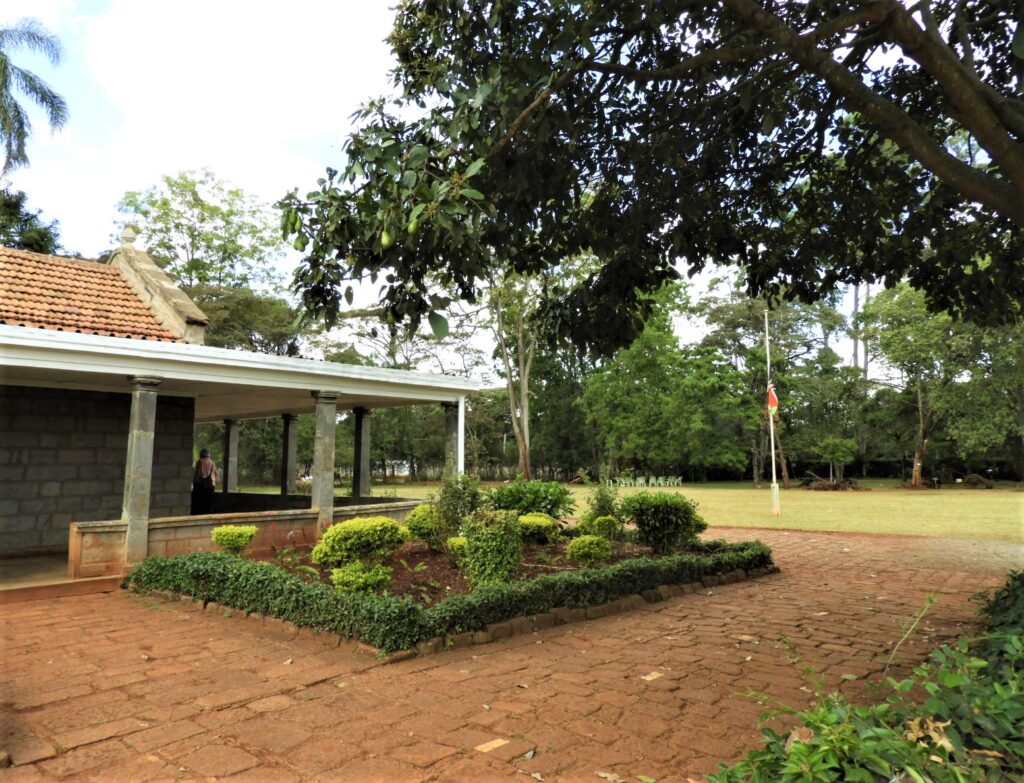 We completed our walk around the house, imagining the crowds gathered there daily, the workers, the children playing, the goats grazing. Here is where the big natives dances (ngomas) were held, with as many as a thousand Maasai coming to celebrate. Here is where Karen sat with Denys, listening to Mozart on the victrola he brought her. Here is where Karen’s belongings were sold when she lost the farm, and here is the last thing Karen saw, that day in 1931 when she had to leave Africa forever.
We completed our walk around the house, imagining the crowds gathered there daily, the workers, the children playing, the goats grazing. Here is where the big natives dances (ngomas) were held, with as many as a thousand Maasai coming to celebrate. Here is where Karen sat with Denys, listening to Mozart on the victrola he brought her. Here is where Karen’s belongings were sold when she lost the farm, and here is the last thing Karen saw, that day in 1931 when she had to leave Africa forever.
 Our tour of the Karen Blixen Museum was over. I complimented Benjamin for the excellent presentation he made, thanked him for for the kindness of the green chair, wished him well. Rick waved to Daniel, and Blethwell, who were waiting with our vehicle just down the drive. We were quiet on the ride through the Karen suburb back to our hotel on Kenyatta Avenue, just thinking, I guess.
Our tour of the Karen Blixen Museum was over. I complimented Benjamin for the excellent presentation he made, thanked him for for the kindness of the green chair, wished him well. Rick waved to Daniel, and Blethwell, who were waiting with our vehicle just down the drive. We were quiet on the ride through the Karen suburb back to our hotel on Kenyatta Avenue, just thinking, I guess.
Karen Blixen Museum, Karen Road, Nairobi https://www.kenyamuseumsociety.org/karen-blixen-museum/
Residence in Kenya 1914-1931
Out of Africa published 1937
» posted on Sunday, September 11th, 2022 by Linda Lou Burton
Karen Says
Linda Lou Burton posting from Nairobi, Kenya – “Remember me?” The Elephant Feeding was over now; the crowd filing out. Blethwell was on my left, Rick on my right, which is where  the voice came from. We paused, and there was Douglas! Douglas, who brought us from the airport Friday night. Rick stepped over, grabbed his hand. In all this crowd, here was a friend, remembering us. We stopped to chat, delighted to see a familiar face. Douglas had brought a group for the Elephant Feeding, he explained; he and Blethwell worked together, Globus representatives. We headed on, past the stables towards our vehicle; Daniel had pulled as close to the gate as possible. “Pole, pole,” he said as he helped me up my ladder step. “Are you ready for lunch?” “The Karen Blixen Museum is MY priority today,” I replied. “When do we go THERE?” “It’s open all afternoon,” Blethwell-the-scheduler answered. “First you get to relax over a nice lunch.”
the voice came from. We paused, and there was Douglas! Douglas, who brought us from the airport Friday night. Rick stepped over, grabbed his hand. In all this crowd, here was a friend, remembering us. We stopped to chat, delighted to see a familiar face. Douglas had brought a group for the Elephant Feeding, he explained; he and Blethwell worked together, Globus representatives. We headed on, past the stables towards our vehicle; Daniel had pulled as close to the gate as possible. “Pole, pole,” he said as he helped me up my ladder step. “Are you ready for lunch?” “The Karen Blixen Museum is MY priority today,” I replied. “When do we go THERE?” “It’s open all afternoon,” Blethwell-the-scheduler answered. “First you get to relax over a nice lunch.”
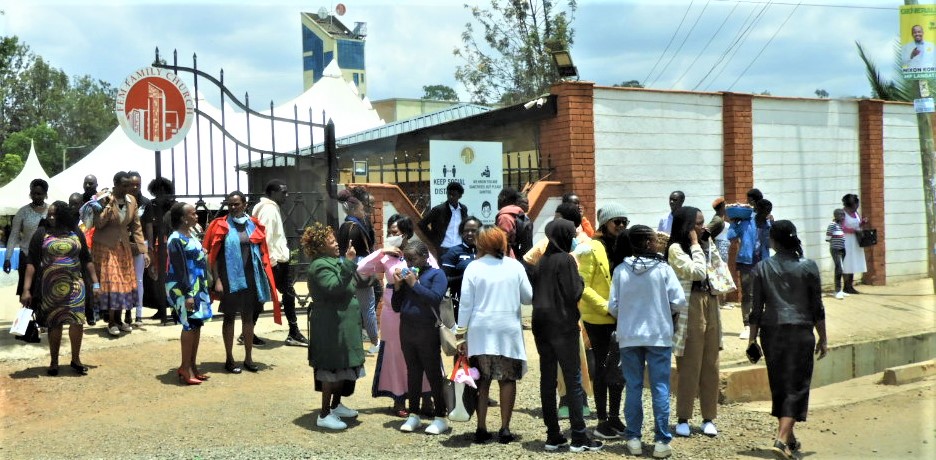 Daniel made a left past Galleria Mall, easing onto Langata Road. It was Sunday-after-church time and crowds were spilling onto the streets. “Where are all the church people going to eat?” I inquired, thinking how fun it would be to go there, the way we did after-church lunch in the old days when the kids were little. “They’re going for Sunday chicken,” Daniel laughed,
Daniel made a left past Galleria Mall, easing onto Langata Road. It was Sunday-after-church time and crowds were spilling onto the streets. “Where are all the church people going to eat?” I inquired, thinking how fun it would be to go there, the way we did after-church lunch in the old days when the kids were little. “They’re going for Sunday chicken,” Daniel laughed, 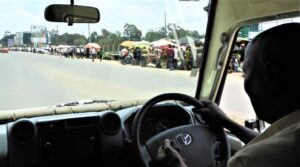 pointing to the stands lining the streets. We passed Karen Hospital, crossed over Karen Road, made a right at Ngong Road. Then he slowed, turned left into a walled area, gated, guarded. It began to sink into my consciousness: we left our hotel through a guarded gate; we entered the Giraffe Centre and the Elephant Orphanage through guarded gates, and now, were we to have our Sunday lunch in a guarded area? Apparently so.
pointing to the stands lining the streets. We passed Karen Hospital, crossed over Karen Road, made a right at Ngong Road. Then he slowed, turned left into a walled area, gated, guarded. It began to sink into my consciousness: we left our hotel through a guarded gate; we entered the Giraffe Centre and the Elephant Orphanage through guarded gates, and now, were we to have our Sunday lunch in a guarded area? Apparently so.

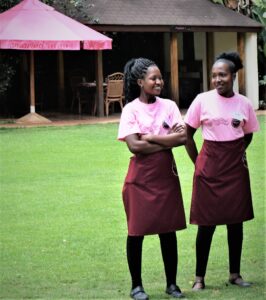
 Tamarind Brasserie was a secluded, palm-surrounded haven of privacy, with individual covered patios around the perimeter of the grounds. Staff in pink uniforms sang greetings as we entered; I was escorted to my chair. “I’ll bring your food,” a beautiful young server said to me, “just tell me what you’d like.” Rick headed for the buffet with her; soon she returned with a perfectly arrayed plate of vegetables and rice for me; just what I’d requested. I thanked her, and commented on the peacefulness of the area. She smiled. “My name is Amani,” she said. “It means ‘peace’ in Swahili.”
Tamarind Brasserie was a secluded, palm-surrounded haven of privacy, with individual covered patios around the perimeter of the grounds. Staff in pink uniforms sang greetings as we entered; I was escorted to my chair. “I’ll bring your food,” a beautiful young server said to me, “just tell me what you’d like.” Rick headed for the buffet with her; soon she returned with a perfectly arrayed plate of vegetables and rice for me; just what I’d requested. I thanked her, and commented on the peacefulness of the area. She smiled. “My name is Amani,” she said. “It means ‘peace’ in Swahili.”
During the course of our lunch, as Amani continued to lavish attention on me, we exchanged details of our lives. “I share an apartment with my sister,” she said in answer to my question. “Whoever gets home first in the evening cooks for the other. We work long hours and have long drives so don’t have much spare time.” She asked about my life in the states; I drew an air-map of the US, pointing to my spot in the southern part of the country. By the time we got to dessert, Amani told me she planned to leave Kenya, explaining there were no jobs where she could use her education. “Where will you go?” I asked. “One of three places – Canada, Australia, or Germany,” she answered. “Pick Australia!” I laughed. “I’ve never met an Aussie I didn’t like, and Canada can get COLD in the winter.”
Blethwell appeared, checking to see if we were done; leading us across the grassy lawn, through the palm trees and flowers to the drive where Daniel waited with our vehicle. “Where did YOU guys eat lunch?” I inquired as we exited the gate. “A Sunday chicken place,” Daniel laughed. When we turned down Karen Road, I saw a sign advertising the Karen Blixen Museum ahead. We were in the Karen suburb, the white enclave of Nairobi.
I remembered a line from Karen Blixen’s Out of Africa book, written years after she left. Her 6,000-acre coffee plantation was a highlands area about ten miles from the 1913 town of Nairobi. Her dream for the natives – the Kikuyu and the Maasai that were such a part of her life – didn’t work out the way she’d hoped. Her plantation was bought by a company that dug up the coffee trees and divided the land into 20-acre plots. Her grief expressed in writing: “now the lands where my natives lived and worked are paved with tennis courts.”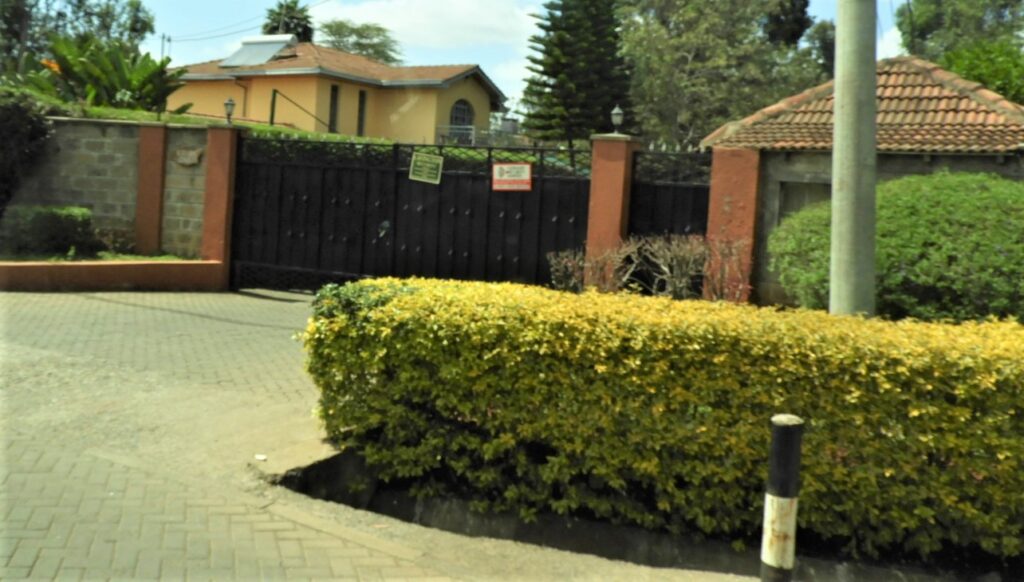
“That’s MY house,” Daniel joked, pointing to a rooftop visible behind a gated stone wall. As we continued down the road, I noted lean-tos on the outside of these barbed-wire topped mansion walls. I am puzzled now, really paying attention to my surroundings. “Karen” describes itself today as “a center for many upscale restaurants and hotels in the city, offering cuisines from around the world. It is a vibrant residential suburb characterized by big mansions, many trees, tranquil atmosphere, and plush gardens. 
Depends, I guess, which side of the wall you’re on.
Next Stop: Karen Blixen Museum
» posted on Sunday, September 11th, 2022 by Linda Lou Burton
Horton’s Who in Action
Linda Lou Burton posting from Nairobi, Kenya – Blethwell began to nudge us down the Giraffe Centre’s ramp. “The Elephant Orphanage is only open one hour a day,” he explained. “We need to be there by 11.” Reluctantly we signed the Guest Book and headed for our vehicle, which Daniel had moved inside the gate, already savvy to my cane-assisted slow walk. ”Pole, pole,” he said, helping me climb the ladder-step he attached to our vehicle and offering me his arm for leverage. “Slowly, slowly.” “Pole” is pronounced “po-lay”, by the way.
 It was just four miles to Sheldrick Elephant Orphanage, which occupies an edge of Nairobi National Park. Traffic was heavy as we pulled into the drive; reservations had to be made far in advance for this special one-hour-a-day Elephant Feeding Time. Guards in uniforms, with guns, checked our ID at the gate. “We’ll have to stand back and observe,” Blethwell explained as we walked to the viewing area. “No interaction with the baby elephants is allowed, because the objective is to eventually re-integrate them into their native habitat.”
It was just four miles to Sheldrick Elephant Orphanage, which occupies an edge of Nairobi National Park. Traffic was heavy as we pulled into the drive; reservations had to be made far in advance for this special one-hour-a-day Elephant Feeding Time. Guards in uniforms, with guns, checked our ID at the gate. “We’ll have to stand back and observe,” Blethwell explained as we walked to the viewing area. “No interaction with the baby elephants is allowed, because the objective is to eventually re-integrate them into their native habitat.”
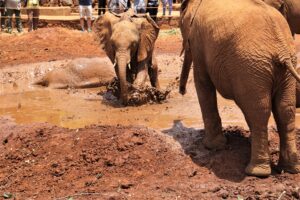
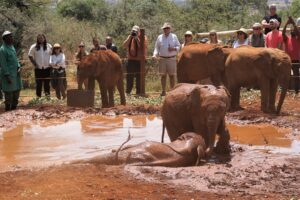
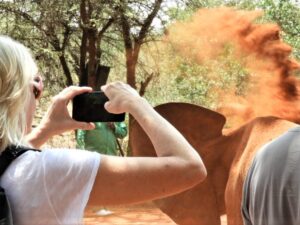 I found a bench on a raised terrace for watching, but Rick moved closer to the rope-enclosed ring, which was already surrounded by camera-toting viewers, already snapping pictures of the cutest scene since God made mud puddles. MUD PUDDLES! What kid can resist a MUD PUDDLE? A 2-year-old toddler elephant may weigh 1,900 pounds, but no amount of weight interferes with FUN. Splashing battles! Plopping flat right in the middle of the clay-red messy waters of the Baby Pond. Grabbing a trunkful of red clay dust and flinging it in the air to dry off.
I found a bench on a raised terrace for watching, but Rick moved closer to the rope-enclosed ring, which was already surrounded by camera-toting viewers, already snapping pictures of the cutest scene since God made mud puddles. MUD PUDDLES! What kid can resist a MUD PUDDLE? A 2-year-old toddler elephant may weigh 1,900 pounds, but no amount of weight interferes with FUN. Splashing battles! Plopping flat right in the middle of the clay-red messy waters of the Baby Pond. Grabbing a trunkful of red clay dust and flinging it in the air to dry off.
I thought cuteness had peaked off the scale, but no – a troop of “surrogate mothers” came marching out loaded with giant baby bottles and slurping time began. Our Master of Ceremonies explained that the formula is NOT elephant milk, but a mixture of coconut milk (closest to mother’s in fat content) and vitamins. As each baby slurped the treasured nectar, the name of each of the 27 babies was called out; each one’s age, where it was found and rescued, and the circumstances that created its “orphan” status. A mother who was killed by a poacher? A mother who died of starvation? A mother who was lost?
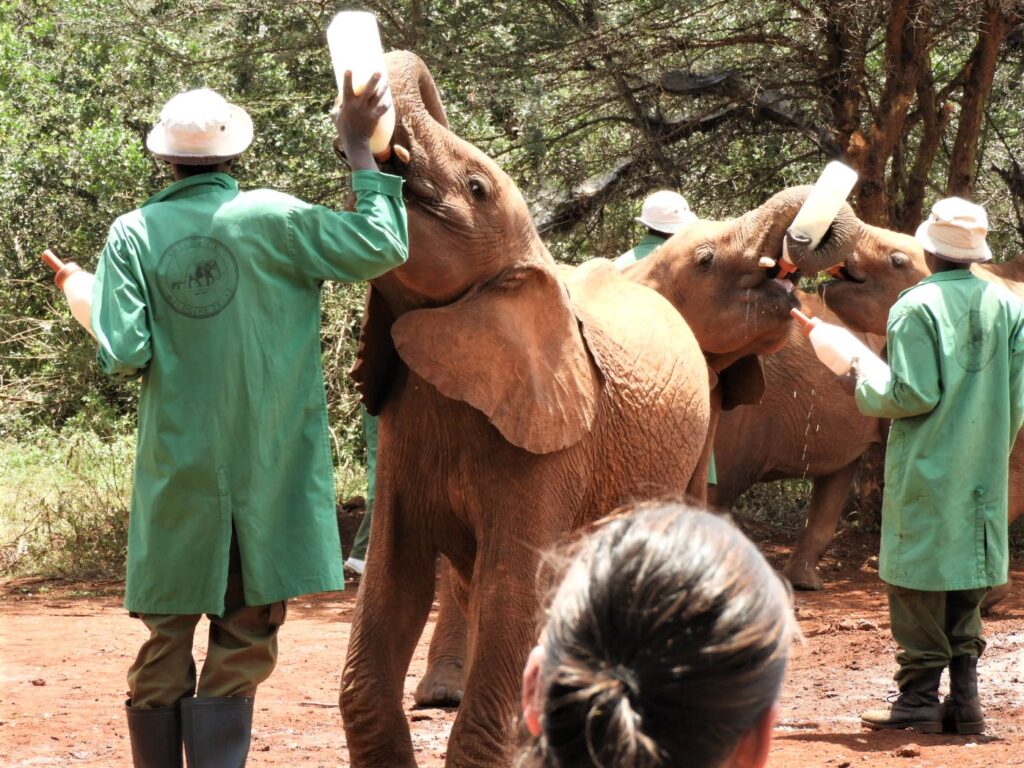 The tales of rescue and survival moved our attention back and forth. Heart wrenching cruelty. Loving 24-hour attention. Remember Horton Hears A Who from your Dr Seuss days? It made me think of that. The MC went on to tell us about each baby’s “keeper” – the green-coated boot-wearing guys who were handing off baby bottles as we watched. Here is the story of a baby’s evening:
The tales of rescue and survival moved our attention back and forth. Heart wrenching cruelty. Loving 24-hour attention. Remember Horton Hears A Who from your Dr Seuss days? It made me think of that. The MC went on to tell us about each baby’s “keeper” – the green-coated boot-wearing guys who were handing off baby bottles as we watched. Here is the story of a baby’s evening:
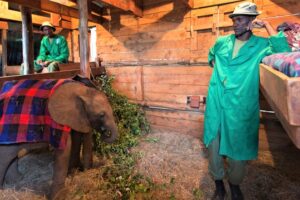 Each bedroom is stocked with a fresh layer of hay, a bundle of cut greens, and two bottles of warm milk. Freshly laundered blankets sit neatly folded over stable doors, ready to be tied around the babies bellies. The orphans know which room is theirs and make a beeline for it, eager to settle down for the evening. The Reintegration Units have communal sleeping arrangements, but the Nursery orphans have individual stockades. Baby elephants are very fragile and, in the wild, they sleep protectively cocooned by their herd. We replicate that experience through cozy, hay-lined quarters. Of course, they never sleep alone; a Keeper bunks with each baby, providing company, care, and milk feedings throughout the night. They are often called upon to give the babies a reassuring cuddle when thunder and rain batters the stable roof.
Each bedroom is stocked with a fresh layer of hay, a bundle of cut greens, and two bottles of warm milk. Freshly laundered blankets sit neatly folded over stable doors, ready to be tied around the babies bellies. The orphans know which room is theirs and make a beeline for it, eager to settle down for the evening. The Reintegration Units have communal sleeping arrangements, but the Nursery orphans have individual stockades. Baby elephants are very fragile and, in the wild, they sleep protectively cocooned by their herd. We replicate that experience through cozy, hay-lined quarters. Of course, they never sleep alone; a Keeper bunks with each baby, providing company, care, and milk feedings throughout the night. They are often called upon to give the babies a reassuring cuddle when thunder and rain batters the stable roof.
Sheldrick Elephant Orphanage now ranks in my Top Ten List of Inspiring Places, to be sure. Definitely a HORTON action! I want you to go to the Sheldrick Wildlife Trust website before you do another thing and read about all the things they do. Excellent videos put you RIGHT THERE; many stories to read; and best of all, you can become, a “digital parent” by adopting an orphaned baby yourself. This is an organization you will no doubt contribute to. Generously.
Sheldrick Wildlife Trust: https://www.sheldrickwildlifetrust.org/about
Mission & History
 Born from the Sheldrick family’s passion for Kenya and its wilderness, the Sheldrick Wildlife Trust was established 45 years ago and is best known for its Orphans’ Project, the first and most successful elephant orphan rescue and rehabilitation program in the world. The Sheldrick Wildlife Trust is a pioneering conservation organization based in Nairobi, Kenya, dedicated to the protection of wildlife and the preservation of habitats in East Africa. The Sheldrick Wildlife Trust is a separately registered charity in the UK and is directly supported by Sheldrick Wildlife Trust USA, a registered 501(c)(3) in the United States.
Born from the Sheldrick family’s passion for Kenya and its wilderness, the Sheldrick Wildlife Trust was established 45 years ago and is best known for its Orphans’ Project, the first and most successful elephant orphan rescue and rehabilitation program in the world. The Sheldrick Wildlife Trust is a pioneering conservation organization based in Nairobi, Kenya, dedicated to the protection of wildlife and the preservation of habitats in East Africa. The Sheldrick Wildlife Trust is a separately registered charity in the UK and is directly supported by Sheldrick Wildlife Trust USA, a registered 501(c)(3) in the United States.
Projects
 Orphans Project: At the heart of the Sheldrick Wildlife Trust’s conservation activities is the Orphans’ Project, which has achieved world-wide acclaim through its hugely successful elephant and rhino rescue and rehabilitation program.
Orphans Project: At the heart of the Sheldrick Wildlife Trust’s conservation activities is the Orphans’ Project, which has achieved world-wide acclaim through its hugely successful elephant and rhino rescue and rehabilitation program.
Aerial Surveillance: The Aerial Unit patrols daily to monitor wildlife and deter illegal activity, while offering rapid response assistance to anti-poaching activities and incidents of human-wildlife conflict in the Tsavo Conservation Area and Lamu District.
Anti Poaching: Ivory and rhino horn poaching have a devastating effect on Africa’s wildlife. Accompanied by armed KWS Rangers and supported by Aerial and Canine Units, last year 25 front-line teams patrolled 35,440 miles on foot, recovering and destroying 9,377 snares, seizing 120 weapons, and making 318 arrests.
 Canine Unit: Globally, the trade in illegal wildlife is estimated at $20 billion. Trained tracker dogs and their handlers detect illegal wildlife products, such as ivory, rhino horn, bushmeat, guns, and ammunition, as well as follow poachers’ tracks. Canines are able to detect the smallest trace of scent or footprints.
Canine Unit: Globally, the trade in illegal wildlife is estimated at $20 billion. Trained tracker dogs and their handlers detect illegal wildlife products, such as ivory, rhino horn, bushmeat, guns, and ammunition, as well as follow poachers’ tracks. Canines are able to detect the smallest trace of scent or footprints.
Veterinary Units: Six fully equipped Mobile Veterinary Units respond to wildlife emergencies from snares, spears, arrow and gunshot wounds, working in diverse habitats. 3,204 elephant cases have been treated, and 6,474 other wild animals.
Saving Habitats: Erecting and maintaining fencelines to secure wildlife areas and reduce human-wildlife conflict and providing financial support to empower community-led initiatives to protect areas of biodiversity, in 2020 2,019,480 acres of land were protected with partners, and 500,000+ trees planted.
Water for Wildlife: Construction of a dam outside Amboseli NP, drilling and maintaining 32 boreholes that operate on wind and solar energy in three NP’s, and operating 8 large-capacity water bowsers for emergency water relief are some of the ways SWT works to alleviate the horrific drought problems in Kenya today.
Community Outreach: Dedicated to educating and informing the younger generation about the positive impacts native wildlife can bring to their country, SWT funds more than 60 school field trips per year. Over 24,000 Kenyan school children attend the 11-12 daily mud bath at the Nairobi Orphanage every year.
Dame Daphne Sheldrick (1934-2018), founder of Sheldrick Wildlife Trust
» posted on Sunday, September 11th, 2022 by Linda Lou Burton
Face to Face
 Linda Lou Burton posting from Nairobi, Kenya –Sunday morning in Nairobi and our Globus Tour begins today! It was a pre-safari day, a day for exploring Nairobi; and Rick and I were the only two signed up. Our Globus Guide for the day, Blethwell, and our driver, Daniel, met us in the lobby just at 9 AM, reviewed the day’s itinerary, and escorted us to our Globus 6-passenger transport. Our first stop: the Giraffe Centre.
Linda Lou Burton posting from Nairobi, Kenya –Sunday morning in Nairobi and our Globus Tour begins today! It was a pre-safari day, a day for exploring Nairobi; and Rick and I were the only two signed up. Our Globus Guide for the day, Blethwell, and our driver, Daniel, met us in the lobby just at 9 AM, reviewed the day’s itinerary, and escorted us to our Globus 6-passenger transport. Our first stop: the Giraffe Centre.
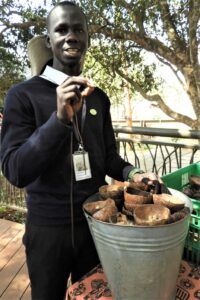 It was an 11-mile drive to the Centre on Duma Road, where our first directive was to “wash our hands.” Just by the front gate, sinks and sanitizers were part of the “allowing in” process. Then a walk up a winding ramp to a stop for a pellet-filled coconut shell (the green pellets are alfalfa, the tan are corn and molasses, guess which was the favorite!). “Hold the pellet between thumb and forefinger and lay it gently on the giraffe’s tongue. Do not lay the pellets out flat in your palm.”
It was an 11-mile drive to the Centre on Duma Road, where our first directive was to “wash our hands.” Just by the front gate, sinks and sanitizers were part of the “allowing in” process. Then a walk up a winding ramp to a stop for a pellet-filled coconut shell (the green pellets are alfalfa, the tan are corn and molasses, guess which was the favorite!). “Hold the pellet between thumb and forefinger and lay it gently on the giraffe’s tongue. Do not lay the pellets out flat in your palm.”
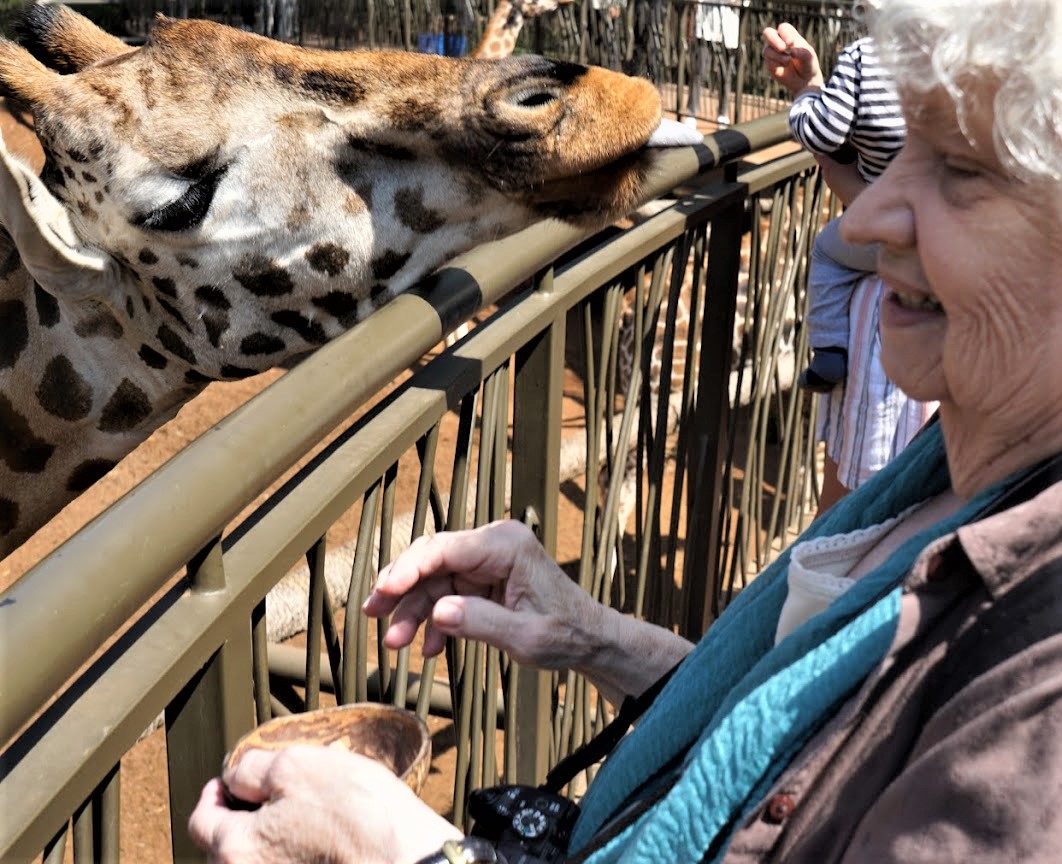
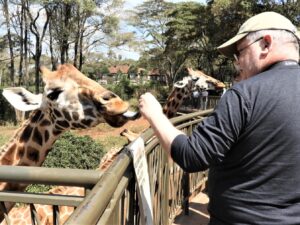
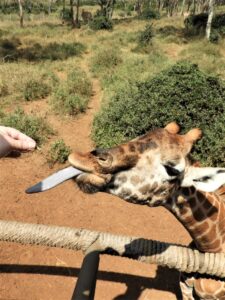 Armed with coconut shells and cameras, we stepped onto the platform that put us FACE TO FACE with the Long Tall Sallys of the animal world. First thing to note: these giraffes were polite but not shy as they fluttered those movie-star eyelashes, extended their long gray-velvet tongues, and downed our offered pellets. Everyone on the ramp was giggling, age no issue. A kid on his Daddy’s shoulders. A gray-headed granny. It was just plain fun.
Armed with coconut shells and cameras, we stepped onto the platform that put us FACE TO FACE with the Long Tall Sallys of the animal world. First thing to note: these giraffes were polite but not shy as they fluttered those movie-star eyelashes, extended their long gray-velvet tongues, and downed our offered pellets. Everyone on the ramp was giggling, age no issue. A kid on his Daddy’s shoulders. A gray-headed granny. It was just plain fun.
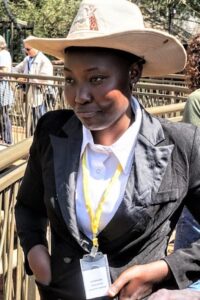 Eunice, the Ranger who was answering questions right and left, called out the names of each giraffe; told us of their good, and bad,
Eunice, the Ranger who was answering questions right and left, called out the names of each giraffe; told us of their good, and bad, 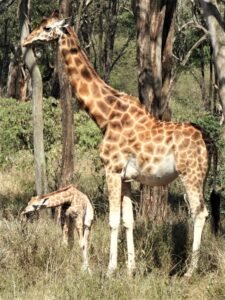 habits. She pointed to the mother and baby standing back under the trees. “The baby is so new we haven’t gotten close enough yet to know if it is male or female,” she told me. I studied Mama and Baby, commenting “A baby has a long way to fall, are they ever injured?”
habits. She pointed to the mother and baby standing back under the trees. “The baby is so new we haven’t gotten close enough yet to know if it is male or female,” she told me. I studied Mama and Baby, commenting “A baby has a long way to fall, are they ever injured?”
The answer: giraffes enter the world front legs and head first, followed by their body, and then back legs. Mama stands for the birth because – well the baby is BIG and its neck is LONG; the 6-foot drop from womb to ground snaps the umbilical cord, tears the birth sac open, and stimulates the baby to take its first breaths. Baby is up and walking within hours, ready to feed, and ready to run, if need be. This protected baby didn’t have a worry!
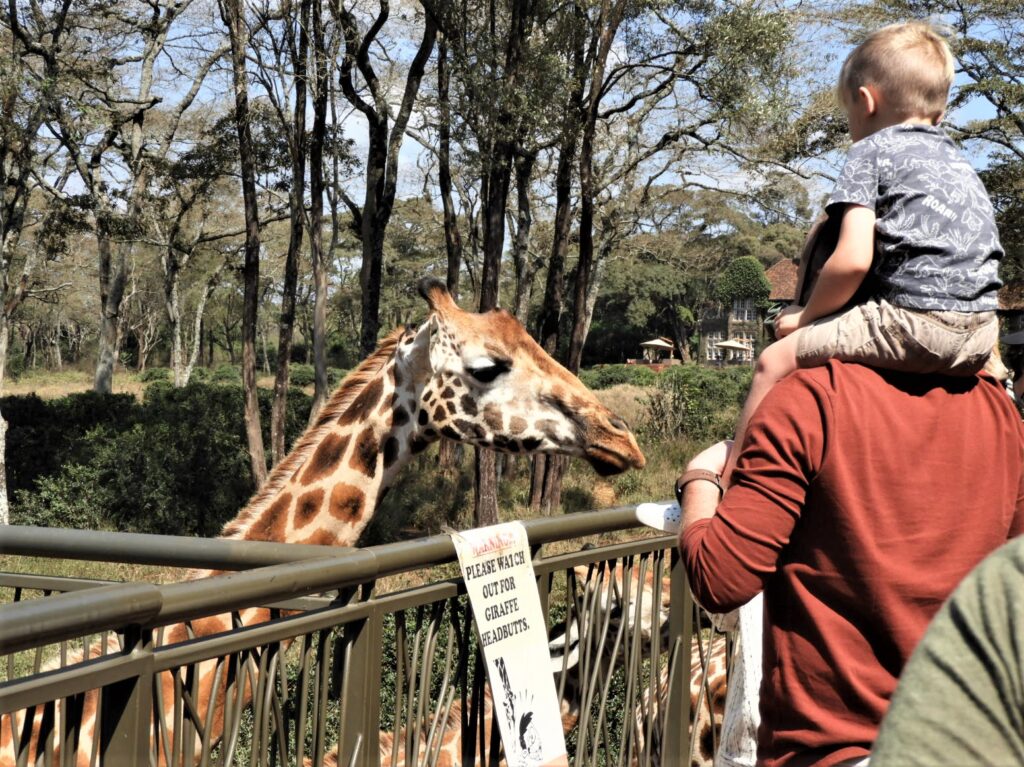 The Giraffe Centre is the creation of the African Fund for Endangered Wildlife (AFEW), a Kenyan non-profit organization. Its main purpose is to educate Kenyan school children and youth on their country’s wildlife and environment, as well as give local and international visitors an opportunity to come into close contact with the world’s tallest species.
The Giraffe Centre is the creation of the African Fund for Endangered Wildlife (AFEW), a Kenyan non-profit organization. Its main purpose is to educate Kenyan school children and youth on their country’s wildlife and environment, as well as give local and international visitors an opportunity to come into close contact with the world’s tallest species. 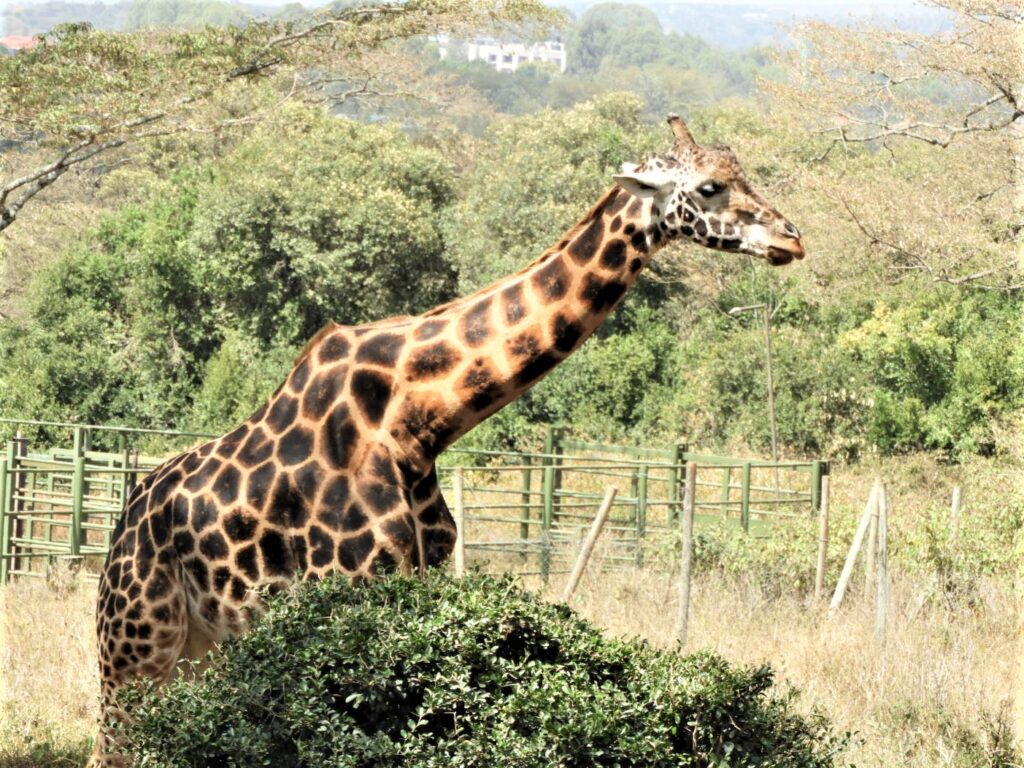
The AFEW was founded in 1979 by Jock Leslie-Melville, a Kenyan citizen of British descent, and his American-born wife, Betty, after discovering the sad plight of the Rothschild Giraffe, a subspecies of giraffe found only in the grasslands of East Africa. At the time, the animals had lost their habitat in Western Kenya, with only 130 of them left. Jock and Betty brought two young giraffes to their home in a Nairobi suburb, Langata, where they started a program of 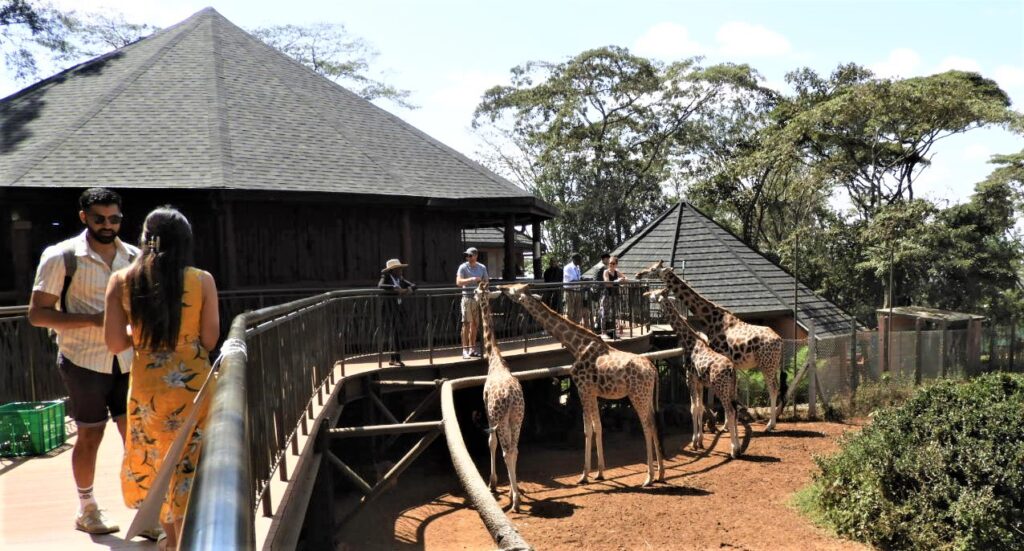 breeding giraffes in captivity. This is where the Centre remains today. In 1983, funds raised by AFEW USA helped build the Educational Centre on this 60-acre sanctuary. The Giraffe Centre opened its doors to the general public and students the same year. There are now over 300 Rothschild Giraffes living safely and breeding well in various Kenyan national parks.
breeding giraffes in captivity. This is where the Centre remains today. In 1983, funds raised by AFEW USA helped build the Educational Centre on this 60-acre sanctuary. The Giraffe Centre opened its doors to the general public and students the same year. There are now over 300 Rothschild Giraffes living safely and breeding well in various Kenyan national parks.
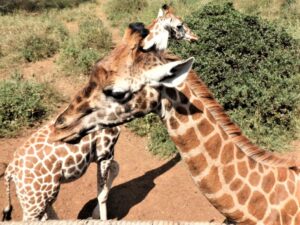 If you can’t make it to Nairobi, then go to the Centre’s website to learn more about the seven females — Betty, the oldest; Kelly, Daisy IV, Salma II, Margaret, Nandi, and Lilly — and the three males, Olerai, Mpingo, and Edd, 18 feet tall and the friendliest; he is father to all the calves. Keep up with the babies via the blogs. And oh yes, a warthog family lives there too! Here’s the link to the site, lots of video. They love donations, be generous.
If you can’t make it to Nairobi, then go to the Centre’s website to learn more about the seven females — Betty, the oldest; Kelly, Daisy IV, Salma II, Margaret, Nandi, and Lilly — and the three males, Olerai, Mpingo, and Edd, 18 feet tall and the friendliest; he is father to all the calves. Keep up with the babies via the blogs. And oh yes, a warthog family lives there too! Here’s the link to the site, lots of video. They love donations, be generous.
Giraffe Centre: https://www.giraffecentre.org/
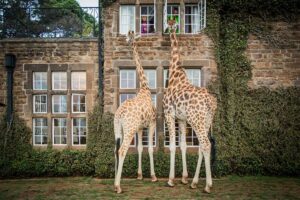 If you CAN go to Nairobi, and really want to get Face to Face, book a stay at the Giraffe Manor, a hotel which is part of the same property (see in background of other photos). In the second-floor suites of the Manor, those same giraffes Rick and I had so much fun feeding might just stick their head in your bedroom window and give you a wake-up call. This is what I call Totally Awesome. Stay in Jock’s Room, or Betty’s, or the Karen Blixen Suite. For a price! Put it on your Bucket List?
If you CAN go to Nairobi, and really want to get Face to Face, book a stay at the Giraffe Manor, a hotel which is part of the same property (see in background of other photos). In the second-floor suites of the Manor, those same giraffes Rick and I had so much fun feeding might just stick their head in your bedroom window and give you a wake-up call. This is what I call Totally Awesome. Stay in Jock’s Room, or Betty’s, or the Karen Blixen Suite. For a price! Put it on your Bucket List?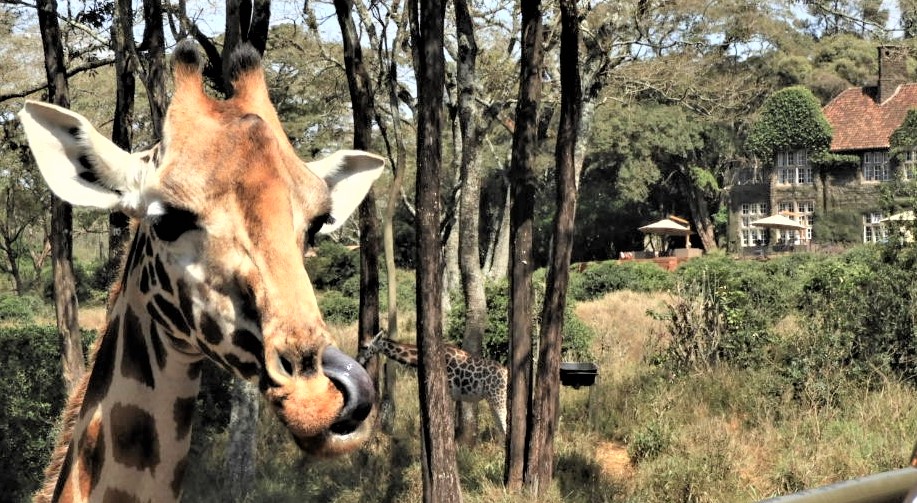
Giraffe Manor: https://www.thesafaricollection.com/properties/giraffe-manor/
Giraffes should be regarded as “intelligent, group-living mammals which have evolved highly successful and complex societies, which have facilitated their survival in tough, predator-filled ecosystems.”


